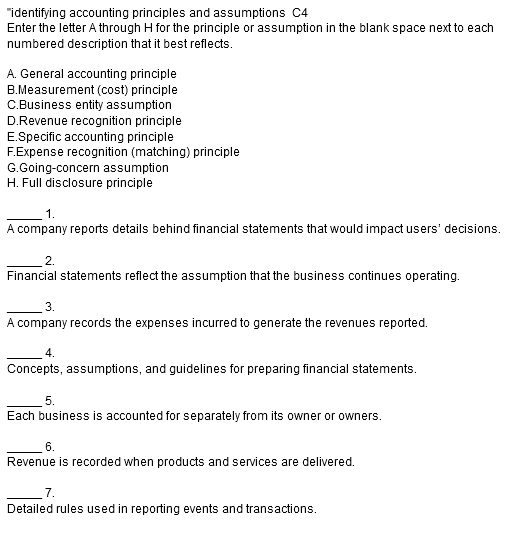"identifying accounting principles and assumptions C4 Enter the letter A through H for the principle or assumption in the blank space next to each numbered description that it best reflects. A. General accounting principle B.Measurement (cost) principle C.Business entity assumption D.Revenue recognition principle E.Specific accounting principle F.Expense recognition (matching) principle G.Going-concern assumption H. Full disclosure principle A company reports details behind financial statements that would impact users' decisions. 2. Financial statements reflect the assumption that the business continues operating. 3. A company records the expenses incurred to generate the revenues reported. Concepts, assumptions, and guidelines for preparing financial statements. 5. Each business is accounted for separately from its owner or owners. 6. Revenue is recorded when products and services are delivered. Detailed rules used in reporting events and transactions.
"identifying accounting principles and assumptions C4 Enter the letter A through H for the principle or assumption in the blank space next to each numbered description that it best reflects. A. General accounting principle B.Measurement (cost) principle C.Business entity assumption D.Revenue recognition principle E.Specific accounting principle F.Expense recognition (matching) principle G.Going-concern assumption H. Full disclosure principle A company reports details behind financial statements that would impact users' decisions. 2. Financial statements reflect the assumption that the business continues operating. 3. A company records the expenses incurred to generate the revenues reported. Concepts, assumptions, and guidelines for preparing financial statements. 5. Each business is accounted for separately from its owner or owners. 6. Revenue is recorded when products and services are delivered. Detailed rules used in reporting events and transactions.
Corporate Financial Accounting
14th Edition
ISBN:9781305653535
Author:Carl Warren, James M. Reeve, Jonathan Duchac
Publisher:Carl Warren, James M. Reeve, Jonathan Duchac
ChapterFS: Financial Statements For Mornin' Joe International
Section: Chapter Questions
Problem 2DQ
Related questions
Question

Transcribed Image Text:8.
Information is based on actual costs incurred in transactions."

Transcribed Image Text:"identifying accounting principles and assumptions C4
Enter the letter A through H for the principle or assumption in the blank space next to each
numbered description that it best reflects.
A. General accounting principle
B.Measurement (cost) principle
C.Business entity assumption
D.Revenue recognition principle
E.Specific accounting principle
F.Expense recognition (matching) principle
G.Going-concern assumption
H. Full disclosure principle
1.
A company reports details behind financial statements that would impact users' decisions.
2.
Financial statements reflect the assumption that the business continues operating.
3.
A company records the expenses incurred to generate the revenues reported.
Concepts, assumptions, and guidelines for preparing financial statements.
5.
Each business is accounted for separately from its owner or owners.
6.
Revenue is recorded when products and services are delivered.
7.
Detailed rules used in reporting events and transactions.
Expert Solution
This question has been solved!
Explore an expertly crafted, step-by-step solution for a thorough understanding of key concepts.
This is a popular solution!
Trending now
This is a popular solution!
Step by step
Solved in 2 steps

Knowledge Booster
Learn more about
Need a deep-dive on the concept behind this application? Look no further. Learn more about this topic, accounting and related others by exploring similar questions and additional content below.Recommended textbooks for you

Corporate Financial Accounting
Accounting
ISBN:
9781305653535
Author:
Carl Warren, James M. Reeve, Jonathan Duchac
Publisher:
Cengage Learning

Corporate Financial Accounting
Accounting
ISBN:
9781305653535
Author:
Carl Warren, James M. Reeve, Jonathan Duchac
Publisher:
Cengage Learning